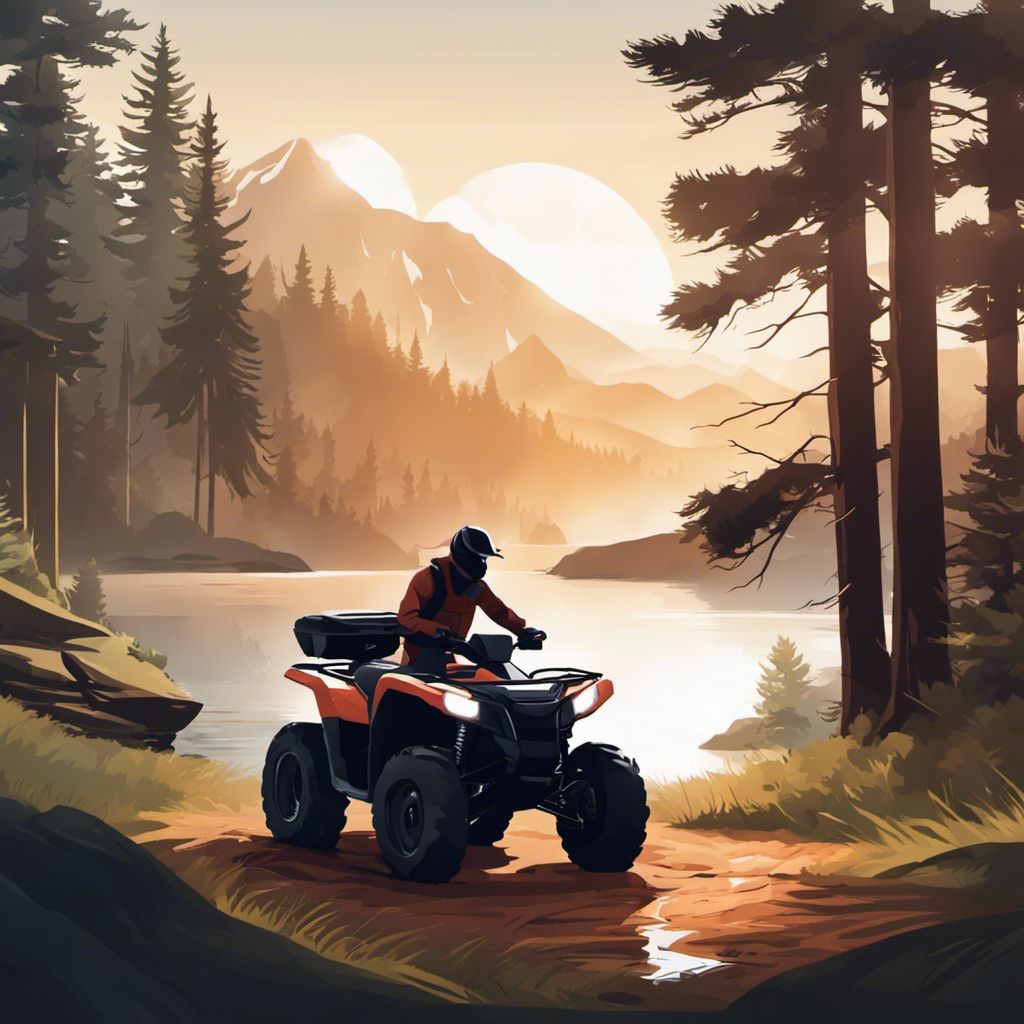We’re familiar with the relentless enemy identified as rust and corrosion. This adversary holds the capability to transform an enjoyable ATV excursion into an ongoing battle with potential harm. Several of us have faced this deteriorating foe, well aware that a small overlooked scrape or the splash from a powerful wave could change our dependable ATVs into dubious chunks of metal.
This blog post will equip you with expert tips and strategies to fortify your off-road sidekick against the perils of rust and damaging corrosion. Ready to safeguard your trusted steed? Let’s dive into action!
Key Takeaways
- Always clean and dry your ATV after rides. This keeps rust away.
- Use a cover for your ATV when not riding. This protects it from weather that can cause rust.
- Coat your ATV with oils or lubes to stop rust. Fix any scratches fast so they don’t turn into rust spots.
- If storing for long, use fuel stabilizer in the tank to prevent rust inside the engine parts.
- Regularly grease fittings to keep them running smooth and free of rust.
- Skid plates guard the bottom part of ATVs against damage and potential corrosion.
- Avoid exposing the engine to water as it may lead to corrosion over time. If it gets wet, make sure you dry it quickly!
- Avoid leaving snow or ice on your ATV; meltwater can lead to quick formation of rust!
Causes of ATV Rust and Corrosion

As avid ATV riders, we know that rust and corrosion can be a significant issue. It’s often the result of exposure to water and moisture – a common hazard when riding in muddy conditions or crossing streams.
Salt is another culprit: whether it’s from use at the beach or road salt during winter rides, its corrosive properties can quickly deteriorate our vehicles. More so, lack of proper cleaning and regular maintenance exacerbates rust development in hidden nooks and crannies that are difficult to reach but still essential for longevity of your offroad vehicle.
Exposure to water and moisture
Water and moisture cause harm to your ATV. They lead to metal oxidation, which creates rust. This kind of rust formation happens fast when we ride through mud or water puddles often.
Mud sticks around and traps wetness against the ATV’s body for a long time. We also see damage if we drive in wet areas or leave our ATVs out in rain or snow. Even a fun day at the beach can hurt our ATVs! Salt from sea air causes oxidative stress on metal parts too.
So, it helps to clean off salt, dirt, and mud as soon as you finish riding. If your ATV goes under water, problems grow bigger. Lots of water gets inside small places where it’s hard to dry out.
Use in salty or wet conditions
Salt is not good for your ATV. It can make rust grow faster. If you ride in salty or wet spots, you have to care for your ATV more.
You need to clean off salt, mud and other things after each ride. This will stop rust from forming. A dry spot is the best place to store an ATV when you’re not using it. We use a sandblaster or wire brush when we see corrosion on our ATVs.
Then we put undercoating on it for protection from salt damage.
Washing and waxing are also important steps in stopping rust. Waxing makes it harder for dirt and grime to stick to your ATV, which keeps moisture away too.
Lack of proper cleaning and maintenance
We can’t stress enough how vital cleaning and maintenance are. ATV rust and corrosion often start from lack of care. It’s not just about running it through a quick rinse either. We need to make sure we clean our ATVs well after each ride.
But, be careful! Power washers or strong cleaners can hurt the seals. Damaged seals allow rust to form faster. Greasing our ATVs on a regular basis also wards off rust issues because it makes it hard for water and dirt to stick around causing harm.
Our ATV’s paint is another line of defense against corrosion too; so if there’s any damage, fixing it right away is key to stopping more problems from starting. Keeping up with all these steps keeps our rides in tip-top shape for many more adventures ahead!
Preventing Rust on Your ATV

To prevent rust on your ATV, always keep it clean and dry – this is the first step. You should also invest in a quality ATV cover to protect your ride from harsh weather conditions.
Regularly applying protective oils and lubricants can create an additional barrier against rust formation. Be prompt about fixing any nicks or scratches as they can expose underlying metal to potential corrosion quickly.
If you plan to store your ATV for extended periods, consider adding a fuel stabilizer to prevent internal engine components from corroding too.
Keep ATV clean and dry
We love a good ride on our ATVs. But riding through mud, grass, or water can leave the ATV dirty. It’s important to clean your ATV after each ride. Mud and grime trap moisture against the metal parts of the ATV.
This trapped moisture can cause rust over time. We have found that using a soft sponge and mild soap is great for cleaning off the debris. Next, dry your ATV well with a towel or let it air dry in a warm space if it’s sunny outside.
By keeping our ATVs clean and dry, we protect them from rust and make them last longer! This is one proven method of rust prevention as part of proper ATV maintenance.
Invest in a cover
We all know how bad weather can harm our ATVs. Buying a cover is one easy step to save your vehicle from rust and corrosion. A good quality cover will keep water, snow, and dust off your ATV.
It’s even better if the cover has Felt-lined interior edges.
Your ATV needs protection not only when riding it but also when you’re just storing it away. Using a cover shields your ride against sharp things that might scratch it or birds who might choose to ‘drop’ on it.
A covered-at-rest-ATV stays looking new for longer, so always put its jacket on!
Use protective oils and lubricants
We can’t stress enough the value of using protective oils and lubricants for your ATV. They form a crucial part in warding off rust and corrosion.
- Grab some protective oil. Aim for one that forms a barrier against rust. A good example is an undercarriage spray you apply to the bottom of the ATV.
- Apply a thin layer of this oil on your ride. It keeps new rust from forming.
- Don’t forget about chain grease! It battles corrosion on the chain, ensuring smooth rides.
- If storing away your ATV for a while, consider using fuel stabilizer with protective qualities.
- Lastly, an undercoating oil seeps through existing rust and chases away moisture, which offers strong defense against more rusting.
Repair nicks and scratches promptly
Look closely at your ATV often. You want to find nicks and scratches right away. It’s easy for rust to start in these small spots. Get a paint kit that matches your ATV color. Fill in the nicks and scratches with the paint from this kit.
Don’t wait, do it now! This stops rust before it begins. Your ATV looks better and lasts longer if you keep up with this job.
Apply fuel stabilizer during storage
Fuel going bad in your ATV can lead to rust. To stop this, use a fuel stabilizer when you store it. This tool stops the gas from getting stale for up to 12 months. It also helps water leave your tank.
Make sure the gas is new before you add the stabilizer though! Old or stale fuel won’t work with a stabilizer well. And if you use ethanol-based fuels, know that a fuel stabilizer might not help much at all.
So drain out any old gas before storage to keep your ATV safe from rust.
Additional Tips for ATV Rust Prevention
It’s critical to grease fittings on your ATV regularly as this will not only ensure smooth operation but also offer extra protection against rust. Skid plates are a smart investment; they shield the underbody of your ATV from debris and potential damage, reducing opportunities for rust development.
Always protect your engine from water exposure as it may lead to corrosion over time. Lastly, after riding in winter conditions, make sure to remove all ice and snow; their moisture content can cause rapid rusting if left unchecked.
These additional measures will help keep your ATV free of rust and extend its lifespan significantly.
Grease fittings regularly
We can’t stress enough the need to grease fittings on your ATVs. This simple act goes a long way in keeping rust at bay. ATV fittings see plenty of water and dirt, so it’s crucial to keep them lubricated after each wash or ride through wet environments.
Yes, reaching some tight spots may be tough but worth every effort! The main goal is to fill up these fittings with grease post-cleaning. In doing so, we not only prevent corrosion but also prolong the lifespan of our beloved ATVs.
Use skid plates
Let’s put skid plates on our ATVs. They guard the bottom part of our ride from harm. Skid plates can stop rust from setting in. This keeps important parts safe and means we are too.
Road salt is less scary with skid plates, but they make it hard to rinse off some spots during a wash. Let’s watch out for rust on the skid plates as well!
Protect the engine from water
Keeping the engine away from water is key for ATV rust protection. Water can seep in and cause damage or rust. We should not ride through deep water if we can avoid it. If the engine gets wet, dry it as soon as possible.
A clean, dry engine is a happy one!
Remove ice and snow
Snow and ice are bad news for ATVs. We have to get rid of them before we put our rides away. Why? They can cause rust if not removed. Ice and snow may seem harmless while frozen but as they melt, they become a problem.
So how do we deal with icy or snowy ATVs? Brushing off the snow works well. Make sure you don’t leave any hanging on your ride! Stay clear of pressure washing though, especially in very cold weather.
Once it’s warm enough outside, make it a priority to take care of any leftover ice. By keeping your ATV free from snow and ice, you’re helping keep rust at bay.
Conclusion
FAQs
1. How can I protect my ATV from rust and corrosion?
You can protect your ATV from rust by cleaning it regularly, storing it in a dry place, and applying an anti-rust spray.
2. Can rust on an ATV be fixed?
Yes, you can fix surface rust on an ATV using tools like sandpaper or wire brush then covering the area with a suitable paint.
3. Why is my ATV getting rusty?
Your ATV may be getting rusty due to exposure to moisture and air without proper maintenance or protective measures applied.
4. What happens if I ignore the rust and corrosion on my ATV?
Ignoring the rust and corrosion on your ATV could lead to serious damage over time including weakened structure and performance issues.
5. Is there special paint that stops ATVs from becoming rusty?
Yes, there are specific paints known as anti-rust paints that create a barrier against moisture thereby preventing your ATV from becoming rusty.

